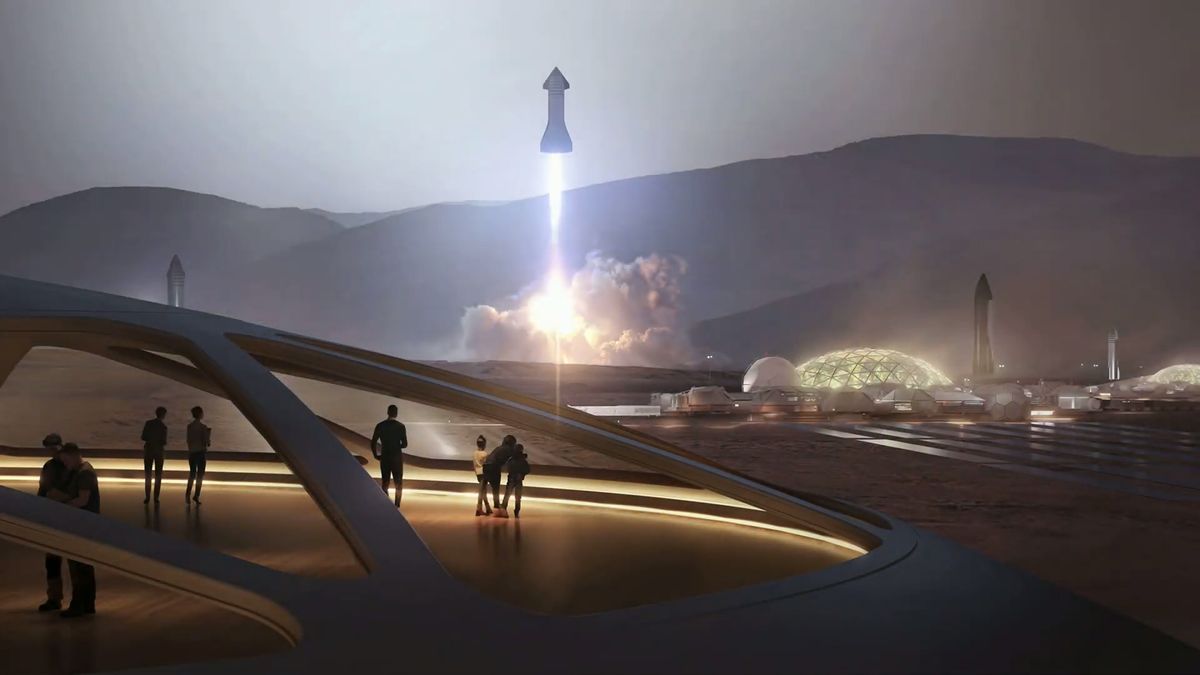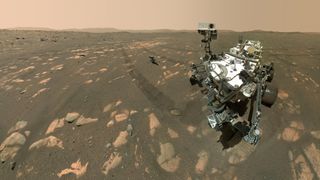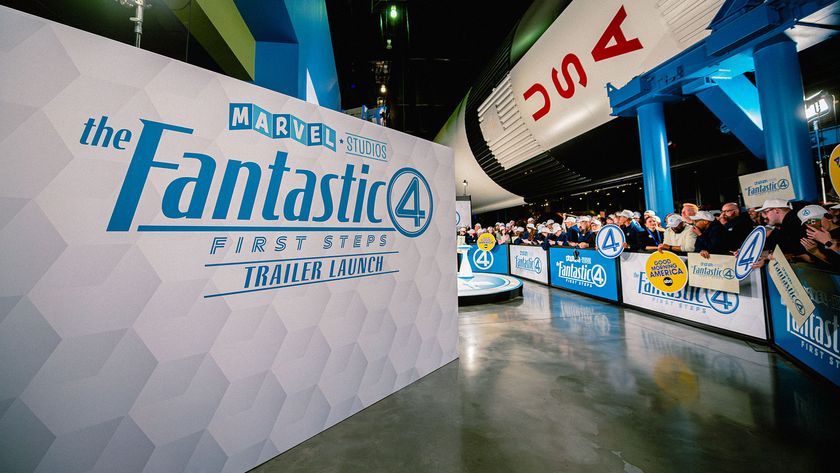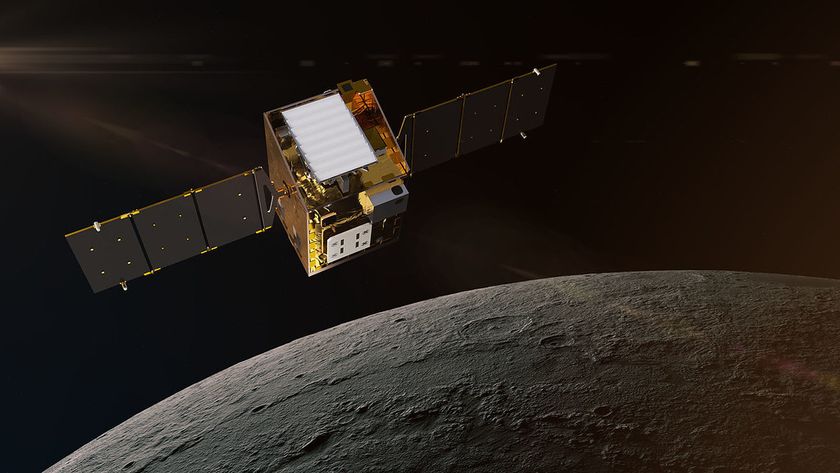Trump wants the US to land astronauts on Mars soon. Could it happen by 2029?
A new report questions whether SpaceX's Starship could take humans to Mars before the decade is out.

President Donald Trump recently announced that the United States would work to land astronauts on Mars, preferably within the next four years — the extent of his presidential term.
That goal has raised many eyebrows. After all, humanity has yet to return to the moon, following repeated delays to NASA's Artemis 2 mission. So, is it even feasible to go from where we are now to putting bootprints in the red Martian dust by 2029?
"A Mars mission will be the greatest undertaking that humans have ever done," said Volker Maiwald, an aerospace engineer from the German Aerospace Center (DLR), in an interview with Space.com.
The president has not provided details about the Mars plan, but it likely relies heavily on SpaceX, the company founded and run by Elon Musk. Musk was a prominent backer of Trump's election campaign and has apparently become one of his most trusted advisers.
SpaceX plans to use its Starship megarocket, which is still in development, to get people to Mars. Starship launched for the seventh time ever on Jan. 16, on a test mission that was a partial success: Its Super Heavy first-stage booster was caught by the "chopstick" arms on the launch tower as planned, but the vehicle's upper stage suffered an explosive failure following a propellant leak near the end of its ascent burn.
Clearly, there's still a lot of work to be done on Starship — though Musk has said that SpaceX aims to launch the vehicle on uncrewed missions to Mars in 2026 and, if those flights are successful, send astronauts there in 2028.
Related: Starship and Super Heavy: SpaceX's deep-space transportation for the moon and Mars
Get the Space.com Newsletter
Breaking space news, the latest updates on rocket launches, skywatching events and more!
Matters of mass and closed-loop systems
The pace of Starship's development is far from the top of Maiwald's list of concerns. In May 2024, he and four fellow researchers published a paper in Nature's Scientific Reports that challenged the feasibility of a crewed mission to Mars on board Starship. To Maiwald and his team, the main problem is mass.
Drawing upon all the publicly available details about SpaceX's Mars plans, Maiwald's team concluded that the required payload mass for a successful Mars mission — including astronauts, equipment, infrastructure, fuel, food, water, air and so on — is greater than what Starship could carry in a single flight.
The key issue is in what Maiwald terms the "recovery rate of consumables" — essentially, the ability to recycle food, water and air. The more that can be recycled, the smaller the amount of supplies that have to be taken on the journey. Plants, for example, are a major factor in increasing the recovery rate of these consumables. They provide food and can grow on waste, and they produce oxygen and remove carbon dioxide from the air.
However, according to the team's calculations, even a 100% recovery rate of consumables wouldn't be sufficient to lower the payload mass enough to meet the mission requirements.
"A 100% recovery rate of consumables means a closed-loop environment," said Maiwald. "But a 100% recovery rate is essentially not possible, since even the best processes will have losses."
Related: Sending astronauts to Mars by 2040 is 'an audacious goal' but NASA is trying anyway

Can enough rocket fuel be made on Mars?
Another consumable is propellant. To reduce the spacecraft's mass, just enough fuel to get to Mars can be carried on board. When on the Red Planet, in situ resource utilization (ISRU) can create new rocket fuel. Starship burns liquid methane and oxygen in its rocket stages, but extracting methane and oxygen from Mars' atmosphere and water ice is not going to be easy.
For one thing, while it sounds like a good idea in principle, the technology hasn't fully caught up with that idea yet.
"As far as I know, the only ISRU experiment that has ever been conducted outside of an Earth environment is by MOXIE, which is an experiment on the Perseverance rover," said Maiwald.
MOXIE is the Mars Oxygen In-situ Resource Utilization Experiment, and in 2021 it succeeded in being the first experiment to extract oxygen from the plentiful carbon dioxide in Mars' atmosphere.
According to NASA, launching just four astronauts off the surface of Mars would require 15,000 pounds (7,000 kilograms) of rocket fuel and 55,000 pounds (25,000 kg) of oxygen. Plus there's the oxygen the astronauts will need to breathe during their stay on Mars.
Initially, MOXIE managed to produce 5 grams of oxygen, which is enough for one astronaut to breathe for 10 minutes. MOXIE was designed to produce up to 10 grams of oxygen per hour when in operation, and by the time the experiment was shut down in 2023, it had produced a total of just 122 grams of oxygen. Clearly, something more efficient than MOXIE is going to be required if astronauts are to survive on Mars.
"This is not a trivial task," said Maiwald. Another challenge is making methane from Martian water ice and atmospheric carbon dioxide. "I do not know of any technology that is close to even being able to test this in a Mars-like environment."
What makes this extra difficult is that the extraction of these resources would likely have to take place independently by robots, without humans to monitor the process, ahead of the arrival of a crewed mission so that oxygen and rocket fuel is awaiting the first astronauts on Mars when they get there. This also brings in the problem of reliability of such an untested technology, without astronauts there to fix it if it breaks down.
Of course, the limitations regarding ISRU on Mars also apply to the moon. The difference is that the moon is three days away by spaceflight, and resupplying any bases there would be relatively trivial. Mars, on the other hand, is at best six months' travel time away, and is often even more distant, depending upon the relative positions of Earth and Mars in their orbits.
Another option would be to launch several uncrewed Starships carrying all the fuel and oxygen that astronauts would need on Mars. With enough supplies for themselves, the astronauts could then make the oxygen and rocket fuel required by the second crew if and when they arrive. "This, however, is not part of the scenarios as published for Starship, as far as I know," said Maiwald. It may have to be adopted as a scenario if there's any hope of launching to Mars by the end of this decade.
Related: SpaceX's giant Starship will be 500 feet tall for Mars missions, Elon Musk says (video)
Radiation risks
Other problems abound. Space is not a safe environment, and astronauts would be at the mercy of cosmic rays and solar radiation. Astronauts going to Mars would receive radiation doses up to 700 times greater than what they would receive on Earth. Measurements by the European Space Agency's ExoMars Trace Gas Orbiter suggest that a six-month journey to Mars would expose astronauts to 60% of their total lifetime recommended radiation dose.
And they wouldn't be much safer on the surface of the Red Planet, which lacks a thick atmosphere and a magnetic field, the two things that protect Earth's surface from cosmic radiation. Even if there were shielded areas on Starship to hide when a solar storm erupts, that would just lessen the risk, not remove it. On the International Space Station (ISS), which is still inside Earth's magnetic field and where there are shielded areas, astronauts nevertheless receive 200 times more radiation than the average airline pilot.
Scientists are working on improving the shielding on crewed spacecraft by conducting experiments in particle accelerators, where they bombard biological cells with the kind of high-energy radiation they would be exposed to in space, and then experimenting with different materials to try and shield those cells. Early results have shown that lithium is the most efficient material for shielding, but further research is required.
And there are other health aspects that can't be ignored. Microgravity wreaks havoc on the body, evolved as we have to live in Earth's gravity, not in space. Muscle atrophy is a common ailment that astronauts must face off, although drugs have been shown to lessen its effects, and recent research has found that microgravity can also damage astronauts' eyesight. A recent study found that at least 70% of astronauts who have been to the ISS for six to twelve months have been affected by spaceflight-associated neuro-ocular syndrome (SANS), which affects the eyes, as a result of pressure from fluids on brain tissue in a microgravity environment.
Although the ocular health of all the astronauts in the study returned to normal once back on Earth, the effects of longer-duration spaceflight are unknown. In addition, a higher percentage of early-onset cataracts as a result of space radiation exposure have been reported by astronauts.
Related: Weightlessness and its effect on astronauts
Can we protect Mars?
If there are question marks about the health of astronauts on a mission to Mars, there are also issues concerning the microbes that they will take with them. Planetary protection is a serious facet of interplanetary exploration. The rules set out by COSPAR, the Committee on Space Research, state that all robotic missions designed to look for evidence of life — as some current and in-development Mars missions do — must be sterilized to such a degree that there is less than a 1-in-10,000 chance that a microbe carried accidentally on board from Earth could contaminate Mars or whichever planetary body that mission is exploring.
Although the astrobiological community is exploring revising this limit, astronauts are essentially big wet sacks of microbes, and any crewed mission is going to inevitably result in some contamination of Mars. The trick is minimizing the impact of such contamination. There are no good answers yet, though, and rushing with undue haste to Mars could result in shortcuts being taken that could greatly increase the risk of contaminating Mars with terrestrial microbes. Should that happen, it would make our attempts to find evidence of life on Mars, either past or present, inordinately more difficult because we would not know whether a microbe was native to Mars or whether it had hitched a ride on a spacecraft.
Ultimately, this might not become an issue. Despite claims to the contrary, the evidence suggests that we are not anywhere near ready to mount a successful crewed Mars mission.
Maiwald's team make some recommendations to help speed thing up. One is to launch uncrewed missions first, to test the reliability of the technology for making oxygen and rocket fuel, for example, or for growing crops on Mars.
A second recommendation is to launch one-way cargo versions of Starship to place all the required infrastructure and supplies on the surface before astronauts reach Mars. Rather than the crew bringing with them habitats that need to be assembled once on the Red Planet, the cargo Starships could be used as habitats instead.
A third recommendation is to focus on developing life-support systems that can get as close to a 100% recovery rate of consumables as possible. Maiwald's team say that this is mandatory, since there's no way a successful mission can be launched without accomplishing this.
Their final recommendation is to include international partners who can help develop the technology and provide funding, albeit with the caveat that international politics and agendas add an extra layer of bureaucracy that can slow the process down. However, since Trump's claim that going to Mars is the manifest destiny (in itself a problematic phrase) of Americans, it remains to be seen how much the United States will want to work with other countries on such a mission.
So, if successfully sending astronauts to Mars by 2029 is unlikely, when does Maiwald think humanity might finally reach the Red Planet?
"The technology development effort is immense and time-demanding," he told Space.com. "I can only say what I always say: I would be happy if it happens in my lifetime."
Join our Space Forums to keep talking space on the latest missions, night sky and more! And if you have a news tip, correction or comment, let us know at: community@space.com.

Keith Cooper is a freelance science journalist and editor in the United Kingdom, and has a degree in physics and astrophysics from the University of Manchester. He's the author of "The Contact Paradox: Challenging Our Assumptions in the Search for Extraterrestrial Intelligence" (Bloomsbury Sigma, 2020) and has written articles on astronomy, space, physics and astrobiology for a multitude of magazines and websites.
-
TomB We won't even be back to the moon by then. Who wants to ride a spacecraft with a record of blowing up? This is just another way to funnel billions of dollars to Musk.Reply -
Moonwatcher Indeed, at the rate of current progress, we will be lucky to back on the moon by 2030. Mars is a great aspirational goal, but there is far too much to be done, designed, and tested. At NASA's current budget of just 0.5% of the Federal budget (half a penny out of each dollar), there simply isn't enough money to get it done in a mere 4-years. Moon by 2030. Establish a base. Learn from it. Mars by 2040, at least an initial landing, then as Konstantine Tsiolkovsky predicted, expand human presence throughout the solar system over the next 1000 years.Reply -
Mars Tafts So with all due respect what has the German Aerospace Center (DLR) launched into space since the V2 that makes them experts on human spaceflight? Passengers on the Space Shuttle? Built a structure for a soft landing probe that crashed into a comet?Reply -
alanm232 I would love to see astronauts labd on Marss, and return if they want by the time frame.Reply -
DrRaviSharma I am not favoring any ideology or any party.Reply
I benefitted from a President's announcement that we had to reach Moon by end of decade and the whole country and many of us from elsewhere contributed as well as received Apollo Awards.
Details were not provided by President, it was a need and a commitment. Learned (Like Von Braun of V2 rockets mentioned in this thread) and Learning teams laid out and step by step executed and scaled to build Saturn V thereafter. Result is Human Lunar landing. There were negative commentaries but overwhelming spirit.
If such commitments would have been made on Fusion, we might have had a powerful or long duration nuclear engine that would have by now provided not only our energy needs with lower risks than fission but would also provide help with Vehicle for interplanetary crewed and robotic missions.
Lofty goals sometime appear to deviate from our wishes for meeting the needs of all sectors of society etc. but in retrospect that money would not have made any significant dent on economic growth.
This forum and community has already discussed robotic missions and have often given low priority to crewed missions. But as a person who was supported by the Moon, I hope next generations would be paid by Mars, our neighbor in space.
If there is political and overwhelming support by representatives, Leaders and Learners can pool enough resources to make Mars happen through the shortest and yet safe (acceptable risk) routes.
Let then the fruits of such great feats reach all!
We are more open than China in our intentions for exploring space so far!
Thanks -
Atlan0001 Reply
A real 'Renaissance Man' with a renaissance-frontier mind. A man of history's 'Frontier Mankind' is now President of the United States! If only he could see, or be told of, the enormity and enormous closeness of the 'High Frontier' surfaces of the Lagrange Points to build artificial gravity stations and (cloud city-state-like) colonies upon first! We need the high seas and surface of the 'High Frontier' first before the surface of Mars (far too little! Far too late! Far too isolated from Mankind's, and life's, needs and wants of frontier birth regarding the Space Frontier! to be first)!Moonwatcher said:At least we have a President who wants to get something done. Remember, Artemis was Trump's idea. Mars is a great goal, but with budget realities, unless NASA is given at least 1 full percent of the bloated Federal budget instead of half that, nothing is ever going to be done quickly, the moon or Mars.
He has the right idea, thank goodness, but the wrong location! And as President Trump should know best of all, it's always "location! location! location!"
If Elon Musk, President Trump's principle adviser in this I think, weren't so fixated, for so long, upon Mars, he would know and understand too! -
gsteele531 Reply
Speaking of imbecilic . . . It's hard to give full credit to the gaggle of mind readers who feel compelled to state their unfounded fantasies as if they had some element of fact, rather than just biased opinion, parroting what they have been gaslighted to believe.SandyRoman said:As one commenter said, there are many obstacles to overcome.
Travel to Mars would be a one way trip and absolutely a death wish. You can't fly off of the surface of Mars. Even a small Mars lander, can't carry that much fuel. You can go down, but you will never come up.
Trump doesn't understand the rocket mass equations and he's just blowing hot air so he can extract money from the treasury with his imbecilic tarrifs.
Should Trump or Elon want to be on the mission that LANDS on Mars, then I would say, let's fund it. They won't do this, of course, they want someone else to go.
This is all utter nonsense. Trump has no actual interest in the USA as a country, nor in technology. He's just having fun, playing with other people's money. Don't be fooled.
On the other hand, since it appears that the majority of Americans have the same opinion on this relentless slander, I guess it is all well and good that they continue, since it's exactly what sickened the voting public enough to throw the purveyors of endless catbirding and phony accusations out of office - so there's that. I suppose we should be thankful, and in their debt. -
Starship Trooper Musk on X "Mass to orbit is the key metric, thereafter mass to Mars surface. The former needs to be in the megaton to orbit per year range to build a self-sustaining colony on Mars."Reply
1875023335891026324View: https://x.com/elonmusk/status/1875023335891026324
Nobody thinks this could be done with a single Starship landing on Mars!
Musk does understand the magnitude of the task, as Werner von Braun understood in his Collier's articles 1952-1954. Anything more than a one way suicide mission would require years of logistic support equivalent to a major military campaign. A MEGATON to low earth orbit per year is a staggering effort. The largest Starship V3 design discussed would deliver 200 tonnes to LEO. Musk admits that he would have to achieve 5,000 Starships launches of this size per year to support a Mars colony.
Generally, as laid out by Bob Zubrin in the last century, a Mars Direct approach would begin with successfully landing many uncrewed cargo ships in the same location on Mars with supplies including construction materials, consumables, mining & drilling equipment, electrochemical reactors for production of methane and oxygen, tankage, and the components of a nuclear power plant. Much of this would have to be done 2 years before the first humans were launched.
Actually, in theory, all of this could be done over decades, but 2029 is wildly unlikely, even for a one way, one astronaut suicide mission to plant a flag. -
ChrisA The big problem with the 2029 date is the Earth-to-Mars launch windows. No matter how much money you have, you can only launch to Mars when the planets have the correct alignment. I mean you just can't fly through the Sun to Get to Mars.Reply
The way you get there has to be to enter into an electrical orbit around the Sun such the the orbit intersects the orbits of the Earth and Mars and you have to time it such that you are Mars are in the same place at the same time. In practice this means you can only launch about every two years (give or take)
The last launch Window was November 2024,
The next is Nov-Dec 2026
The next is Dec-Jan 2028/2029
To we have one opportunity to test in 2026 but that mission will still be flying the return in 2028. So we don't know the result until 2028. Then we put humans on the 2029 launch.
It gets worse because a round trip with a return requires a launch facility on Mars. The 2026 mission would have to leave this in place for the human flight in 2029. So to meet the 2029 deadline we would need to develop that first robotic mission in only about 18 months starting now from zero.
We simply do not have enough launch windows between now and 2029.
The Moon is a better target for developing the technology because we can launch to the moon mny times per year, But we can launch to Mars only about four times per decade.
Most Popular



